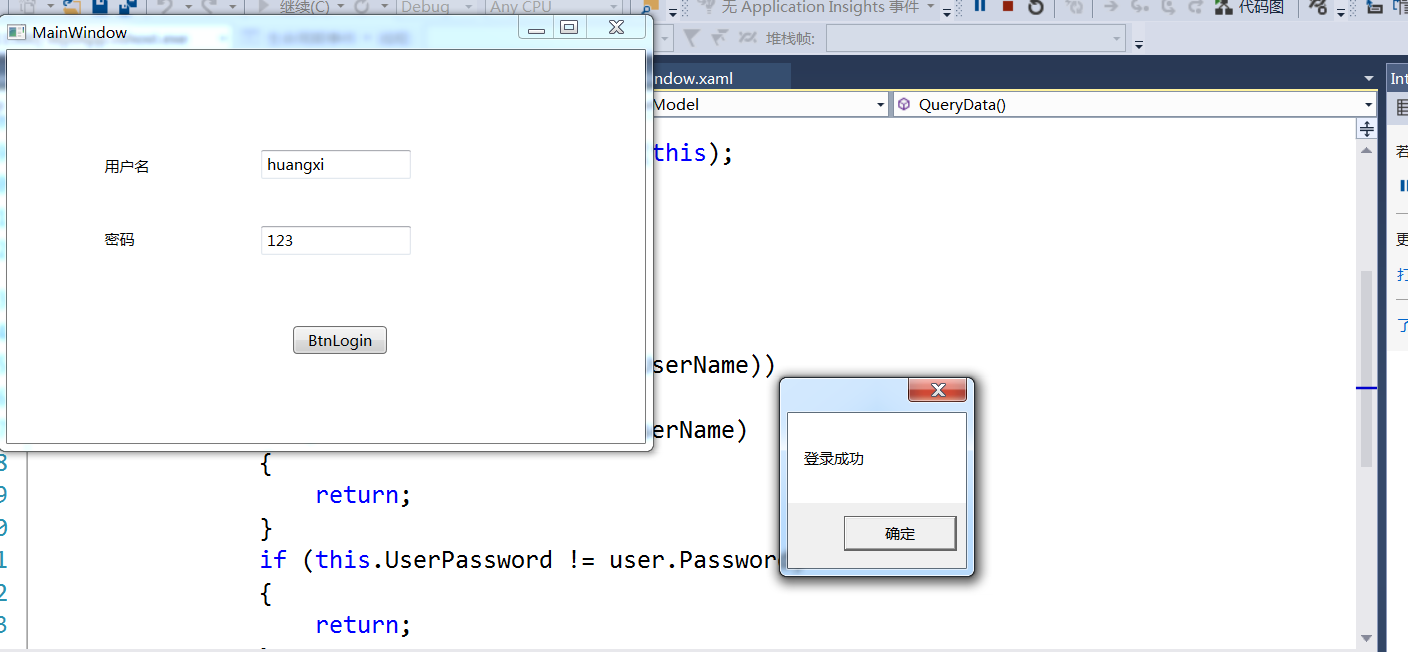Wpf例項-MVVM模式實現的登入窗體
阿新 • • 發佈:2019-02-03
- 程式截圖
2.程式的結構圖
3.說明:
如圖2所示,Model中存放的是User類檔案
using System;
using System.Collections.Generic;
using System.Linq;
using System.Text;
namespace WpfApp.Model
{
public class User
{
public string UserName { get; set; }
public int UserId { get; set; }
public string Password { get ViewModel
using System;
using System.Collections.Generic;
using System.Collections.ObjectModel;
using System.ComponentModel;
using System.Linq;
using System.Text;
using System.Windows.Input;
using WpfApp.Model;
using WpfApp.Command;
using System.Windows;
namespace WpfApp.ViewModel
{
public 還有Command,存放的是Command,實現了ICommand介面
using System;
using System.Collections.Generic;
using System.Linq;
using System.Text;
using System.Windows.Input;
using WpfApp.ViewModel;
namespace WpfApp.Command
{
public class LoginCommand:ICommand
{
private UserViewModel userViewModel;
#region ICommand成員
public bool CanExecute(object parameter)
{
return true;
}
public event EventHandler CanExecuteChanged;
public void Execute(object parameter)
{
userViewModel.QueryData();
}
#endregion
public LoginCommand(UserViewModel userViewModel)
{
this.userViewModel = userViewModel;
}
}
}
最後是View層,
<Window x:Class="WpfApp.MainWindow"
xmlns="http://schemas.microsoft.com/winfx/2006/xaml/presentation"
xmlns:x="http://schemas.microsoft.com/winfx/2006/xaml"
Title="MainWindow" Height="350" Width="525">
<Grid>
<Label Content="使用者名稱" HorizontalAlignment="Left" Margin="73,80,0,0" VerticalAlignment="Top"/>
<Label Content="密碼" HorizontalAlignment="Left" Margin="73,138,0,0" VerticalAlignment="Top" RenderTransformOrigin="0.798,-0.492"/>
<Button Content="BtnLogin" HorizontalAlignment="Left" Margin="229,221,0,0" VerticalAlignment="Top" Width="75" Click="Button_Click"/>
<TextBox x:Name ="txtUserName" HorizontalAlignment="Left" Height="23" Margin="203,80,0,0" TextWrapping="Wrap" VerticalAlignment="Top" Width="120" Text="{Binding UserName,Mode=TwoWay}"/>
<TextBox x:Name="txtPassword" HorizontalAlignment="Left" Height="23" Margin="203,141,0,0" TextWrapping="Wrap" VerticalAlignment="Top" Width="120" Text="{Binding UserPassword,Mode=TwoWay}"/>
</Grid>
</Window>
這裡有一個問題,因為預設的Password沒法繫結,這裡採用的TextBox代替,網路上有很多Password的幫助類,有興趣的同學可以自行百度。
介面層的後臺程式碼
using System.Windows;
using WpfApp.ViewModel;
namespace WpfApp
{
/// <summary>
/// MainWindow.xaml 的互動邏輯
/// </summary>
public partial class MainWindow : Window
{
private UserViewModel userViewModel = null;
public MainWindow()
{
InitializeComponent();
userViewModel = new UserViewModel();
this.DataContext = userViewModel;
}
private void Button_Click(object sender, RoutedEventArgs e)
{
if (this.userViewModel != null)
{
this.userViewModel.UserName = this.txtUserName.Text;
this.userViewModel.UserPassword = this.txtPassword.Text;
this.userViewModel.LoginCommand.Execute(null);
}
}
}
}
到這裡就結束了。


